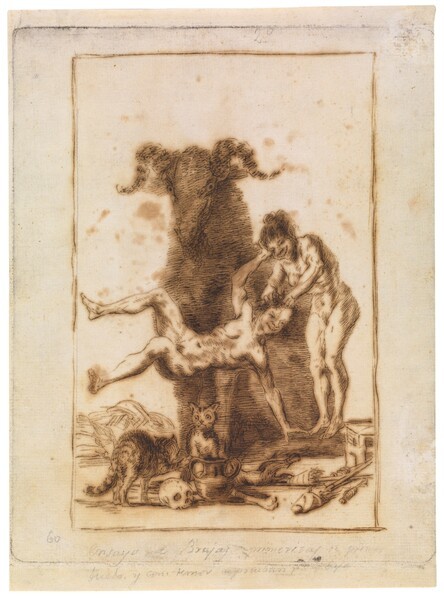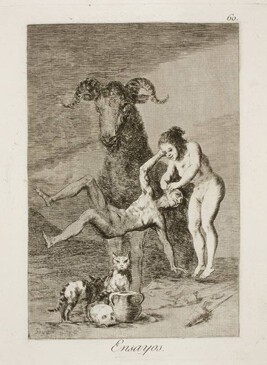- Cronología
- Ca. 1796 - 1797
- Ubicación
- The Prado National Museum. Madrid, Madrid, Spain
- Dimensiones
- 230 x 170 mm
- Técnica y soporte
- Reconocimiento de la autoría de Goya
- Documented work
- Titular
- El Prado National Museum
- Ficha: realización/revisión
- 06 Sep 2022 / 23 Jun 2023
- Inventario
- D4202
2nd (in pencil; recto, upper centre)
60 (in pencil; recto, lower left-hand corner)
Ensayo de brujas primerizas de primer / buelo, y con temor se prueban pª trabajar (in pencil; recto, lower centre)
36 (verso, upper part)
36 (reverse, left)
36 (in red colour; reverse, left)
Watermark: H C WEND / & / ZOONEN
On the gestation, history and aims of the series known as Dreams, a set of preparatory drawings for The Caprices, see Dream 1: Universal Language.
Line of provenance of the present drawing: Javier Goya; Mariano Goya, 1854; Valentín Carderera, ca. 1861; Mariano Carderera, 1880; Prado Museum, 1886.
Within the series of drawings entitled Dreams, the seed of the Caprichos, a group devoted to witchcraft, including the present work, stands out for its number and singular subject matter. They illustrate scenes of which the painter had learned from his friend Leandro Fernández de Moratín (1760-1828), who had been working on the new edition of the Account of the Trial of the Faith celebrated in Logroño in 1610 since 1797. A further ten drawings in this series of Dreams deal with love, while other individual drawings depict donkeys, smugglers and monks. A feature common to all of them is the inscription in black pencil of a legend at the bottom, which in eleven cases begins with the word "dream".
Preparatory drawing for the etching of the Caprice 60. Rehersals. It heads a set of nine drawings on the subject of witches. Goya used witch themes to criticise the ignorance that presides over human behaviour. The scene has also been associated with shadow theatre and magic, a fashion of the time.
For Matilla, this image represents the initiation of a novice into the ritual of flight, assisted by another more experienced witch, the scene presided over by the shadowy silhouette of a billy goat. With its vague outlines, this magical beast acts as a vision that underlines the character of a fantasy world in which the women have taken flight by grasping, respectively, their hair and an ear. On the illuminated areas of the floor, on both sides of the main stage, the witches' clothes appear, as well as some spindles and spinning wheels, the tools of their honourable and abandoned work.
Matilla shows that various magical and sacrificial objects, such as bones and a dead puppy with its legs tied together, were placed in the shadows cast on the floor by the goat. Also worth noting is the human skull and the pitcher that attracts one of the two cats that gather at the feet of the goat. The posture of the novice, with her feet apart, her right hand as a support and extending the other, recalls the classical sculpture of the fallen Gladiator, a frequent model for the figure of Adam in depictions of the Creation or Fall of Man.
In the final engraving, the inexperienced and joyful novice is replaced by a witch who looks at her smiling and luminous teacher with an ambiguous expression, a mixture of debauchery, suspicion and fear, which emphasises not only the enchanting power and promise of life in Paradise, but also implies criticism of those who believe them and allow themselves to be tempted.
-
Goya. La década de Los CaprichosMadrid1992organized by Real Academia de Bellas Artes de San Fernando sponsored by Fundación Central Hispano, Madrid, consultant editor Nigel Glendinnig. From October 26th 1992 to January 10th 1993cat. 26
-
Barcelona2012cat. 37
-
Goya: Order and disorderMuseum of Fine ArtsBoston2014cat. 165
-
Madrid2019cat. 195
-
Melbourne2021
-
Roma D.Anderson: Editeur1908p. 30, n. 60
-
Los Caprichos de Goya y sus dibujos preparatoriosBarcelonaInstituto Amatller de Arte Hispánico1949pp. 94-95
-
Goya’s Caprichos. Beauty, Reason and CaricatureNueva JerseyPrinceton University Press1953p. 205, fig. 207
-
MadridMuseo del Prado1954nº 58
-
Vie et ouvre de Francisco de GoyaParísOffice du livre1970pp. 183, nº 572
-
Dibujos de Goya, 2 volsBarcelonaNoguer1975p. 77
-
El mundo de Goya en sus dibujosMadridUrbión1979pp. 108-109
-
MadridSilex1980pp. 68-69, nº 9
-
MadridReal Academia de Bellas Artes de San Fernando1992pp. 43-45
-
El sueño dibujadoActas de las I Jornadas de arte en Fuendetodos. Realidad y sueño en los viajes de GoyaZaragozaDiputación de Zaragoza1996pp. 50-51, fig. 5
-
MadridMuseo Nacional del Prado1999p. 311
-
MadridFundación bancaria “la Caixa” y Museo Nacional del Prado2012p. 172
-
MadridMuseo Nacional del Prado2019p. 294

